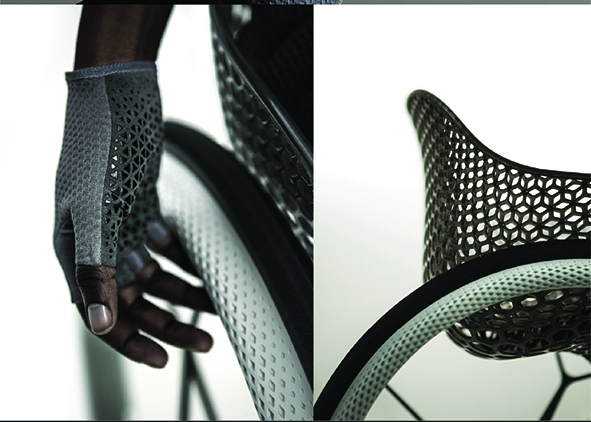Generative design and industrial product. Connecting physical/digital dimensions of the project
DOI:
https://doi.org/10.19229/2464-9309/10142021Keywords:
computational design, morphogenesis, additive manufacturing, form research, parametricismAbstract
The evolution of modelling techniques has made possible to connect in a more efficient way what is physical and what is virtually designed, using simulation processes that have allowed the evolution of conditions of use and material production of the model. This contribution aims to discuss, by presenting emblematic case studies, how the implementation of new virtual technologies of generative parametric modelling has allowed to evolve and improve, in terms of efficiency and innovation, the development of industrial products. Thus, the designer assumes a central role in the experimentation of new design methodologies aimed at the use of virtual models not as a simple formal expression, but as an optimisation process from multiple points of view.
Downloads
Article Metrics Graph
References
Ajla, A. (2016), Integrating Innovation in Architecture – Design, Methods and Technology for Progressive Practice and Research, John Wiley & Sons, Chichester. [Online] Available at: doi.org/10.1002/9781119164807 [Accessed 23 October 2021].
De Giovanni, G. and Sposito, C. (2019) “Dettagli d’autore – Dal disegno manuale dei grandi Maestri a quello digitale delle Archistar | Master’s details – From hand-made drawing of the great masters to the digital drawing of Starchitects”, in Techne | Journal of Technology for Architecture and Environment, vol. 18, pp. 99-109. [Online] Available at: doi.org/10.13128/techne-7516 [Accessed 15 October 2021].
Gallagher, C. L., Reaser, L., Crane, P., Ataide, R. A., Mauerman, D., Undesser, M., Nunez, D. and Ku-shner, A. (2014), Can 3D printing unlock bioinspiration’s full potential?, Fermanian Business & Economic Institute, San Diego. [Online] Available at: docplayer.net/38411869-Can-3d-printing-unlock-bioinspiration-s-full-potential.html [Accessed 25 October 2021].
Langella, C. and Santulli, C. (2017), “Processi di crescita biologica e Design parametrico”, in MD Journal, vol. 3, n. 1, pp. 14-27. [Online] Available at: mdj.materialdesign.it/index.php/mdj/article/view/85 [Accessed 18 October 2021].
Marsault, X. (2017), Eco-generative Design for Early Stages of Architecture, vol. 1, Wiley-ISTE, London-Hoboken.
Migliore, E., Caruso, I. and Giambattista, A. (2015), “Digital materials – La nuova materialità biologicamente digitale”, in Digicult, 02/09/2015. [Online] Available at: digicult.it/it/news/digital-materials-a-new-biologically-digital-materiality/ [Accessed 25 October 2021].
Oxman, R. (2017), “Thinking difference – Theories and models of parametric design thinking”, in Design Studies, n. 52, pp. 4-39. [Online] Available at: doi.org/10.1016/j.destud.2017.06.001 [Accessed 23 October 2021].
Romero, M. E. (2014), “Physical Computing – Strumento progettuale per i designer di oggi”, in Rossi, M. and Casale, A. (eds), Uno (nessuno) centomila – Prototipi in movimento – Trasformazioni dinamiche del disegno e nuove tecnologie per il design – Workshop marzo-maggio 2014, Maggioli, Santarcangelo di Romagna (RN), pp. 125-136. [Online] Available at: re.public.polimi.it/retrieve/handle/11311/848734/87462/unonessunofull.pdf [Accessed 25 October 2021].
Schumacher, P. (2016), “Parametricism 2.0 – Gearing Up to Impact the Global Built Environment”, in Architectural Design, vol. 86, issue 2, pp. 8-17. [Online] Available at: onlinelibrary.wiley.com/toc/15542769/2016/86/2 [Accessed 25 October 2021].
Schumacher, P. (2009), “Parametricism – A new global style for architecture and urban design”, in AD Architectural Design, vol. 79, issue 4, pp. 14-23. [Online] Available at: doi.org/10.1002/ad.912 [Accessed 26 October 2021].
Sennett, R. (2008), L’uomo artigiano, Feltrinelli, Milano.
Stinson, L. (2017), “John Maeda – If You Want to Survive in Design, You Better Learn to Code”, in Wired, 15/03/2017. [Online] Available at: wired.com/2017/03/john-maeda-want-survive-design-better-learn-code/ [Accessed 20 October 2021].
von Uexküll, J. (2015), Biologia Teoretica, Macerata, Quodlibet.

Downloads
Published
How to Cite
Issue
Section
License
This Journal is published under Creative Commons Attribution Licence 4.0 (CC-BY).
License scheme | Legal code
This License allows anyone to:
Share: copy and redistribute the material in any medium or format.
Adapt: remix, transform, and build upon the material for any purpose, even commercially.
Under the following terms
Attribution: Users must give appropriate credit, provide a link to the license, and indicate if changes were made; users may do so in any reasonable manner, but not in any way that suggests the licensor endorses them or their use.
No additional restrictions: Users may not apply legal terms or technological measures that legally restrict others from doing anything the license permits.
Notices
Users do not have to comply with the license for elements of the material in the public domain or where your use is permitted by an applicable exception or limitation.
No warranties are given. The license may not give users all of the permissions necessary for their intended use. For example, other rights such as publicity, privacy, or moral rights may limit how you use the material.


















































































